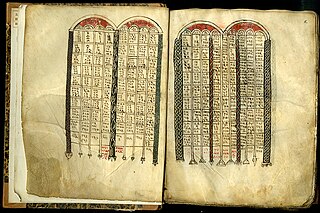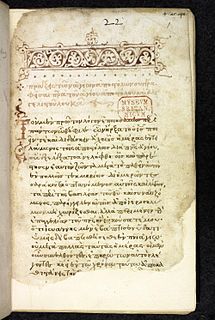| New Testament manuscript | |
| Name | Fragmentum Uffenbachianum |
|---|---|
| Text | Hebrews 1-4; 12-13 † |
| Date | 10th-century |
| Script | Greek |
| Now at | University of Hamburg |
| Size | 26 cm by 21 cm |
| Type | mixed |
| Category | III |
Uncial 0121b (in the Gregory-Aland numbering), it was named as Fragmentum Uffenbachianum, or Codex Ruber. It is a Greek uncial manuscript of the New Testament, dated palaeographically to the 10th-century. [1] The manuscript is very lacunose.
The codex contains parts of Hebrews 1:1-4:3; 12:20-13:25 on two parchment leaves (26 cm by 21 cm). The text is written in two columns per page, 45 lines per page, in small semi-uncial letters, [1] in red ink (hence Codex Ruber). The accents and notes of aspiration are carefully marked, but the iota subscriptum does not occur anywhere. [2] The Iota adscriptum occurs three times, ν εφελκυστικον is rare. The interrogative (;) occurs once (Heb 3:7), and the inverted comma (>) is often repeated to mark quotations. [3]
The letters are a little unusual, small in form, and their character is between uncial and minuscule, and in the 19th century the codex was classified as a minuscule manuscript (catalogue number 53). Tregelles argued that they are more uncial by character, they are almost entirely separate, and sometimes joined in the same word. "They are certainly by no means cursive, in the common acceptation of the term". [4] According to Scrivener they "can hardly be called semicursive". [3] According to Günther Zuntz it is an uncial manuscript, its letters are that kind of uncial script, which scribes of the 10th and later centuries used. [5]
The size is the same as in Uncial 0121a, the number of lines is almost the same, and characters of letters are similar, therefore they were originally described and classified as the same manuscript (f.e. F. H. A. Scrivener). [3] They received catalogue number 0121 in the Gregory-Aland system. Now after more accurate examination, they are unanimously considered to belong to different manuscripts.
The Greek text of this codex is a representative of the mixed text-type. Aland placed it in Category III. [1]
It does not contain Hebrews verse 2:1. The omission is supported by minuscules 1739 and 1881 [6]
In Hebrews 2:9 it reads χωρὶς θεοῦ (apart from God) for χάριτι θεοῦ (by the grace of God). The reading of the codex is supported by 424 c, 1739, mss, Peshitta, Origen, Theodore of Mopsuestia, St. Ambrose of Milan, St. Jerome, Fulgentius, Theodoret. [7]
Currently it is dated by the INTF to the 10th-century. [1] [8]
The manuscript came from Italy. It once belonged to H. van der Merk. In 1712 it was in The Hague. [9]
The manuscript once belonged to Conrad von Uffenbach (hence the name Fragmentum Uffenbachianum), then to J. C. Wolf, and after his death in 1739 to the Public Library of Hamburg. It was very imperfectly described by Maius, Wettstein, Griesbach, and Bengel. [2] Tregelles collated its text twice. Constantin von Tischendorf edited its text in 1855 (with 5 errors) and in 1861 corrected these 5 errors.
The codex now is located in the University of Hamburg (Cod. 50), in Hamburg. [1] [8]

Codex Borgianus, designated by T or 029, ε 5, is a Greek and Sahidic uncial manuscript of the Gospels, dated palaeographically to the 5th century. The name of the codex came from its former owners.

Codex Mutinensis designated by Ha or 014, α 6, is a Greek uncial manuscript of the Acts of Apostles, dated paleographically to the 9th century. The codex contains 43 parchment leaves.

Codex Angelicus designated by Lap or 020, α 5, is a Greek uncial manuscript of the New Testament. Palaeographically it has been assigned to the 9th century. Formerly it was known as Codex Passionei.

Codex Campianus is designated as "M" or "021" in the Gregory-Aland cataloging system and as "ε 72" in the Von Soden system. It is a Greek uncial manuscript of the New Testament, dated palaeographically to the 9th century. The manuscript has complex contents. It has marginalia and was prepared for liturgical (religious) use.

Codex Tischendorfianus III – designated by siglum Λ or 039, ε 77 – is a Greek uncial manuscript of the Gospels on parchment. Palaeographically it has been assigned to the 9th or 10th century.
Codex Vaticanus 2066, designed by 046 (in the Gregory-Aland numbering), α 1070 (von Soden), formerly it was known also as Codex Basilianus, previously it was designated by Br or B2. It is a Greek uncial manuscript of the New Testament written on vellum. The manuscript paleographically has been assigned to the 10th century by the INTF, though some palaeographers proposed the 9th century. Scrivener proposed even the 8th century.
Codex Vaticanus Graecus 2061, usually known as Uncial 048, α1 (Soden), is a Greek uncial manuscript on parchment. It contains some parts of the New Testament, homilies of several authors, and Strabo's Geographica. Formerly it was known also as the Codex Basilianus 100, earlier as Codex Patriniensis 27. It was designated by ב a, p.
Uncial 056 (in the Gregory-Aland numbering), O7 (von Soden), is a Greek uncial manuscript of the New Testament, dated paleographically to the 10th century.

Codex Basilensis A. N. IV. 2, Minuscule 1, δ 254 and formerly designated by 1eap to distinguish it from minuscule 1rK is a Greek minuscule manuscript of the New Testament, usually dated palaeographically to the 12th century CE. It contains the entire New Testament apart from the Book of Revelation.

Uncial 098, α 1025 (Soden), is a Greek uncial manuscript of the New Testament, dated palaeographically to the 7th-century. It is also named Codex Cryptoferratensis.

Uncial 0121a, α 1031 (Soden), is a Greek uncial manuscript of the New Testament, dated paleographically to the 10th-century.
Minuscule 81, or α162 is a Greek minuscule manuscript of the New Testament, on a parchment. It is dated by a colophon to the year 1044. Formerly it was labelled by 61a and 61p (Gregory). The manuscript is lacunose. It was adapted for liturgical use.

Uncial 0142 (in the Gregory-Aland numbering), O6 (Soden), is a Greek uncial manuscript of the New Testament, dated paleographically to the 10th century. Formerly it was classified as a minuscule manuscript of New Testament under numbers 46a 55p (Scrivener).
Uncial 0243, is a Greek uncial manuscript of the New Testament. Paleographically it has been assigned to the 10th century.

Minuscule 385, α 506 (Soden), is a Greek minuscule manuscript of the New Testament, on paper. Dated by a colophon to the year 1407 (May). The manuscript has no complex context. Formerly it was designated by 60a, 63p, and 29r.
Minuscule 451, α 178, is a Greek minuscule manuscript of the New Testament, on parchment. Palaeographically it has been assigned to the 11th century. Formerly it was labelled by 79a and 90p. The manuscript has not survived in complete condition.

Minuscule 480, δ 462, is a Greek minuscule manuscript of the New Testament, on parchment. It is dated by a colophon to the year 1366. The manuscript is lacunose. The manuscript was adapted for liturgical use. It has marginalia. It contains liturgical books with hagiographies: Synaxarion and Menologion.
Minuscule 566, ε 93 (Soden), also known as the Empress Theodora's Codex. It is a Greek minuscule manuscript of the New Testament, on parchment, dated palaeographically to the 9th century.
Minuscule 629, α 460, is a Latin–Greek diglot minuscule manuscript of the New Testament, on parchment. It is known as Codex Ottobonianus. Palaeographically it has been assigned to the 14th century. The manuscript is lacunose. It is known for the Comma Johanneum.
Minuscule 630, α 461, is a Greek minuscule manuscript of the New Testament, on paper. It is known as Codex Ottobonianus. Palaeographically it has been assigned to the 12th or 13th century. The manuscript is lacunose. Formerly it was labeled by 163a and 201p.